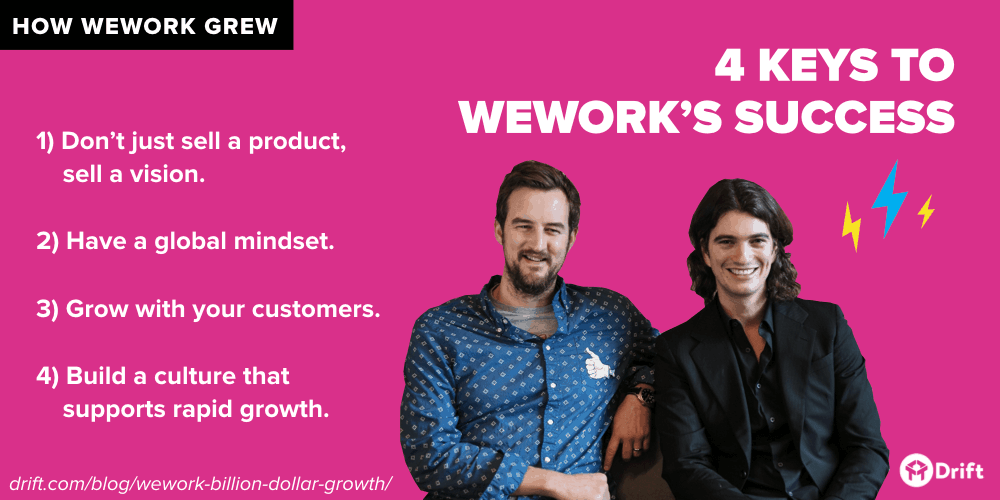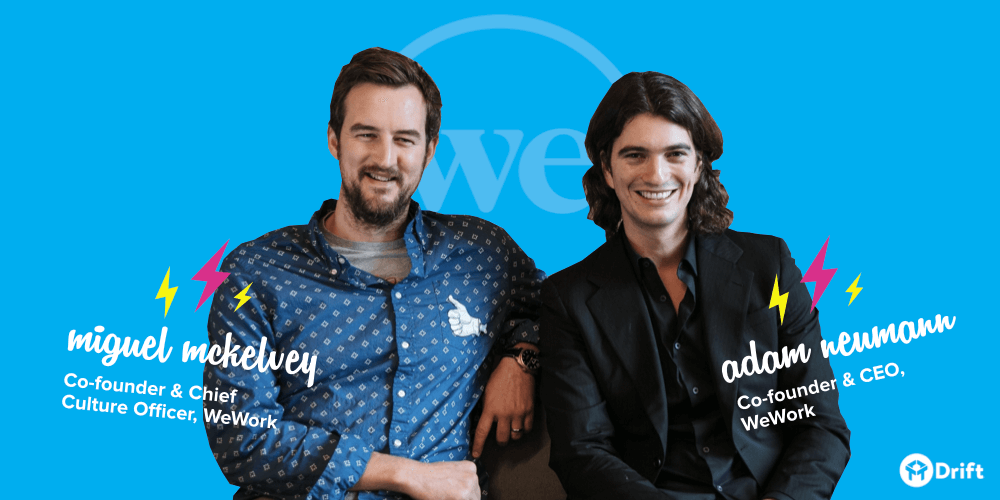
Editor’s Note: WeWork announced on Monday, April 29 2019 that it confidentially filed to go public.
If you’re reading this post, we’re guessing you’ve heard of WeWork. And chances are you might’ve even spent a day or two (or much longer) working in one of WeWork’s distinct, modern coworking spaces. Heck, you might even be in one right now. Maybe you’ve just gotten back from grabbing a coffee from the communal kitchen. Or maybe you just played a game of foosball with your friend from that startup (you know, the one that makes that thing?).
If it feels like WeWork coworking spaces have been popping up in nearly every city (and on nearly every street corner) over the past few years, that’s because… well, they have been.
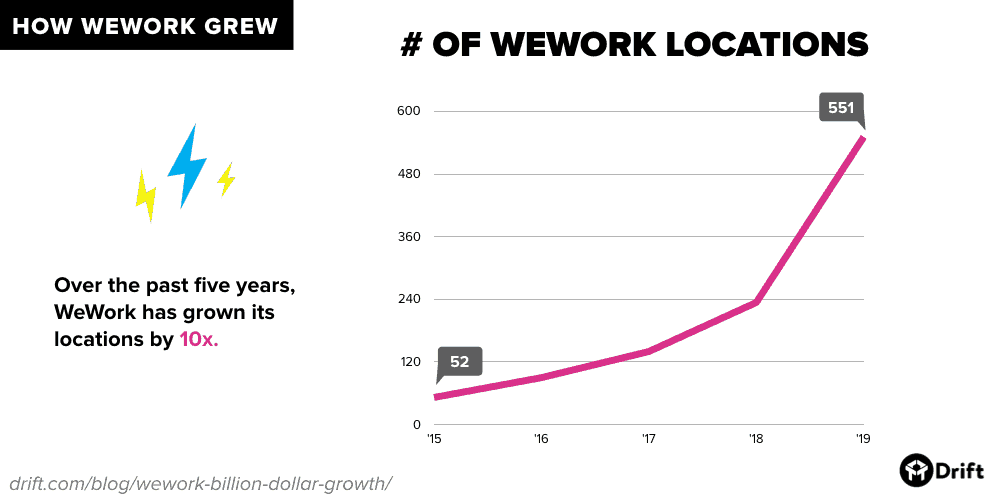
Today, WeWork operates 500+ office spaces in 32 countries around the world. They have around 100 office spaces in New York City alone, and recently earned the distinction of being Manhattan’s largest office-space landlord.
Not too shabby for a company that launched in 2010 with a single location.
But in order to really grasp how staggering WeWork’s growth has been, just look at their valuation — a whopping $47 billion — which makes WeWork the second-largest private unicorn in the country (right behind Uber).
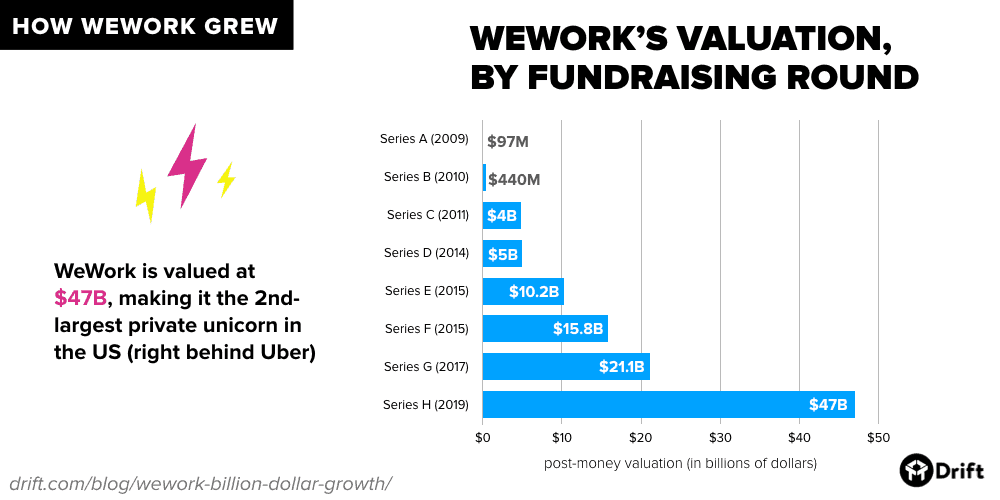
In total, WeWork has raised more than $13 billion. With each round of funding, its valuation has soared higher and higher. Clearly, investors see the value in WeWork’s coworking spaces. And it turns out that many self-employed workers and large employers alike see the value as well — and they’ve been showing their appreciation with their wallets.
Between 2016 and 2017, WeWork’s revenue grew from $436M to $886M. In 2018, revenue swelled to $1.8B, marking a second straight year of 100%+ revenue growth.
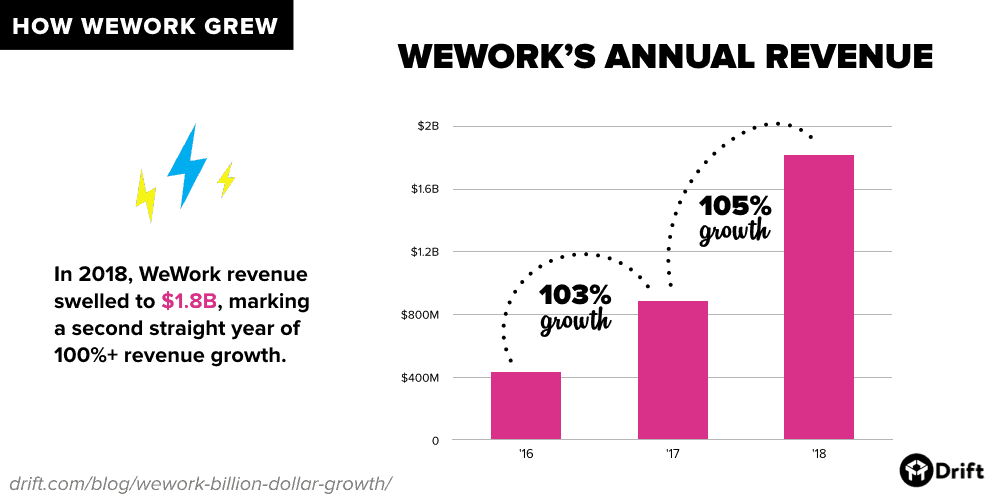
Now, if you’re familiar with these types of growth articles (we’ve done them on a bunch of companies, including Zapier, Glossier, Stripe, and Squarespace) you know what comes next. Now we try to answer the question: How did they do it? How did WeWork grow from $0 to $47 billion in less than a decade?
Keep reading to uncover four key lessons behind WeWork’s unprecedented growth.
In a hurry? Here’s the tl;dr version:
- Don’t just sell a product, sell a vision. WeWork’s co-founders didn’t invent the concept of coworking spaces. Instead, they started with a shared vision of workspaces designed to inspire collaboration and a sense of community. That vision continues to propel the company forward.
- Have a global mindset. Before they became a household name in the U.S., WeWork began expanding internationally. From the get-go, its co-founders envisioned WeWork as a global opportunity.
- Grow with your customers. In the early days, small startups made up a large chunk of WeWork’s clientele. Inevitably, many of those startups started getting bigger and wanting their own spaces. Instead of waving goodbye to these customers, WeWork evolved alongside them.
- Build a culture that supports rapid growth. WeWork doesn’t treat company culture as a set-in-stone list of rules. Instead, they use culture as an instrument for helping the company scale and allow it to change and evolve when necessary.
1) Don’t just sell a product, sell a vision.
At first glance, WeWork’s co-founders Adam Neumann, former owner of a children’s clothing company, and Miguel McKelvey, former lead architect at a boutique architecture firm, might seem like the ultimate odd couple. In fact, they only ever met in the first place because they happened to work in the same building. What compelled them to join forces on a project as ambitious as WeWork?
It turns out that Adam (now WeWork’s CEO) and Miguel (now WeWork’s Chief Culture Officer) have a shared life experience: Both grew up in communal living environments. Adam was raised on a communal farm in Israel known as a kibbutz, while Miguel was brought up in a commune in Oregon. Suddenly, WeWork’s origin story starts to make a bit more sense…
In 2008, Adam and Miguel noticed that the building they worked in was mostly vacant, and convinced the landlord to lease them a space to use as a coworking office. The duo’s first company, GreenDesk, was the result, and it ended up being a proof of concept for WeWork.
In 2009, Adam and Miguel realized that the opportunity to turn their shared values of community and collaboration into a business was much bigger than they had anticipated with GreenDesk. So, they sold the old company off and began working on a new idea — a new vision.
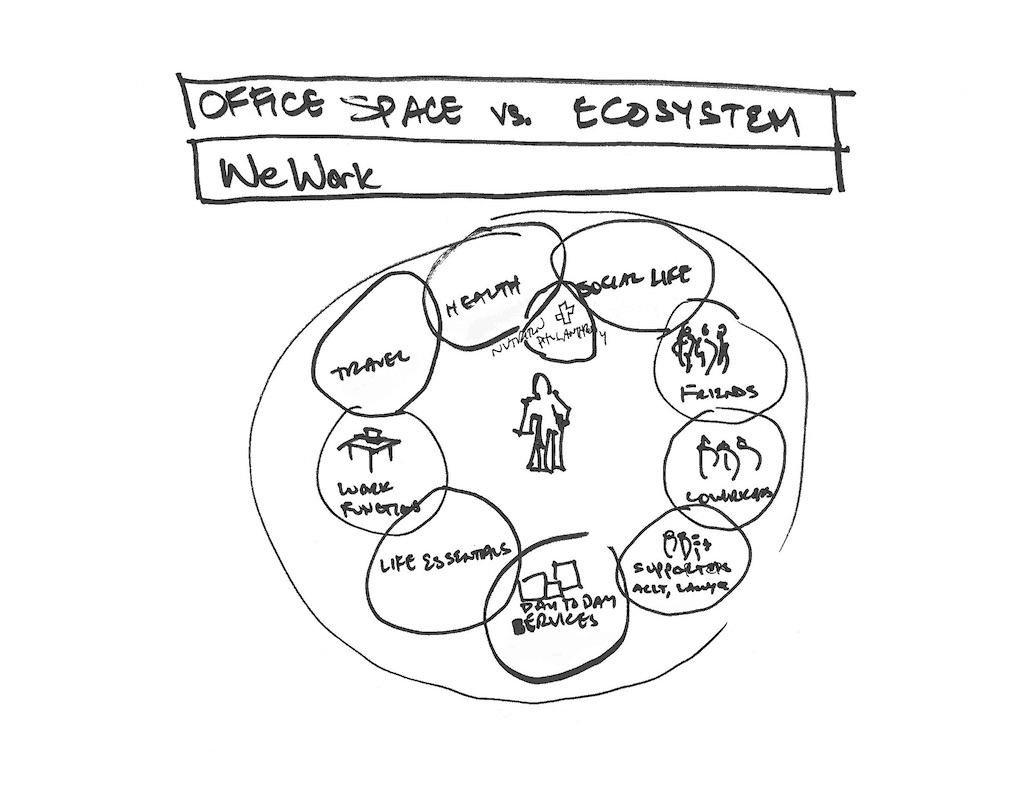
(Pictured above: The vision for the WeWork ecosystem, drawn by Miguel McKelvey in 2009)
Since its inception, WeWork has been about more than simply renting out desks and office space, it’s been about bringing people together and making the office experience part of a more fulfilling and satisfying life. To quote Adam:
Nine years ago, we had an idea. We thought that if we created a community that helped people live life with purpose, we could have a meaningful impact on the world.
When we started in 2010, we had just one building, a vision for a brand, and conviction that there was an entrepreneurial spirit that was being underserved. We knew there were creators all around the world who needed a place to call home…
The idea that began in New York nine years ago was always about more than work — it was about supporting all aspects of life.
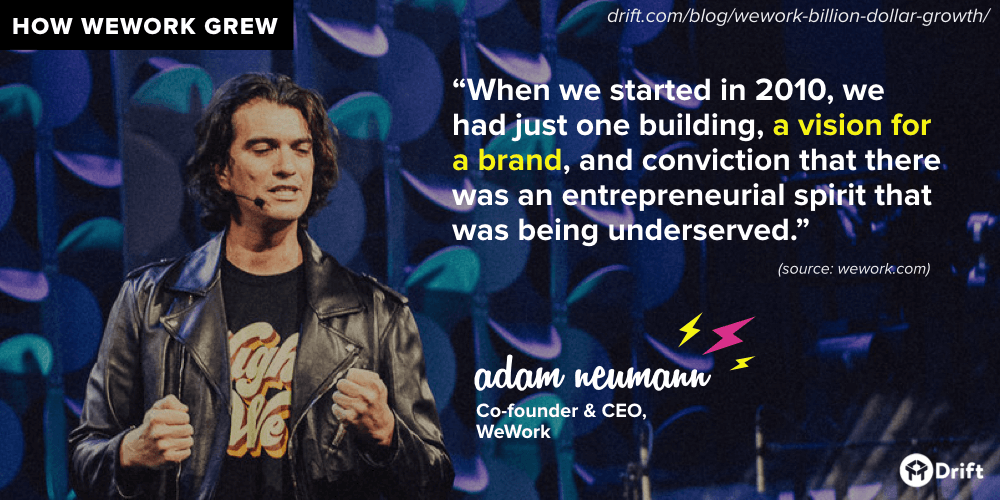
By creating a home for entrepreneurs who might otherwise work out of coffee shops (or basements or garages), WeWork is bringing people together, creating hubs of collaboration. As Adam explained in an interview with the New York Times:
How do you change the world? Bring people together. Where is the easiest big place to bring people together? In the work environment.
Once you choose to enter a WeWork, you choose to be part of something more “we” than “me.” People start coming together. They’ll see each other in the elevator, they talk in the stairways. There’s a thousand other things they do.
☝️ That’s what WeWork is selling. Not desks, or office space, but a community.
2) Have a global mindset.
After launching in New York in 2010, WeWork quickly expanded into other major tech hubs, opening coworking spaces in Boston, San Francisco, Seattle, and Los Angeles. Then, in 2014, WeWork went all-in on spreading its community-focused business around the globe. After just a few years in operation, and before WeWork had even become a household name in the U.S., the company opened coworking spaces in London, and then Tel Aviv. By 2016, WeWork had a coworking space in Shanghai, the first of its now 100+ locations in Asia. As Adam explained:
In 2014, we made a bold decision to expand internationally to cities of the world at the same speed that we were building in the U.S…
Through the extended WeWork network, we now touch approximately 5 million people around the world, and we are confident that we will reach many more in the near future. What started as an idea now reaches people in all corners of the world from different backgrounds and unique cultures.
Instead of developing a huge brand presence in the U.S. first — before opening up shop abroad, which is what companies like Starbucks and Walmart did when they expanded internationally — WeWork opted to buck tradition. As WeWork’s COO Jennifer Berrent explained at the Fast Company Innovation Festival, one of the reasons why the company was able to scale so fast was they decided to grow their brand presence “all around the world at the same time.” Even in WeWork’s earliest days, they had a global outlook and a global strategy for their brand.
Ultimately, however, it all comes back to WeWork’s underlying vision (which we talked about earlier). Because when Adam Neumann and Miguel McKelvey founded WeWork, they did so with the understanding that building communities and bringing people together would have a global appeal. It’s a concept that’s been baked into WeWork’s DNA since day one. As Miguel told Wired:
What we wanted to invest in was building a community, and we saw it as a global opportunity. From the beginning, we saw this as an emerging mentality of people who want to be more connected — who want to find purpose and meaning in their work.
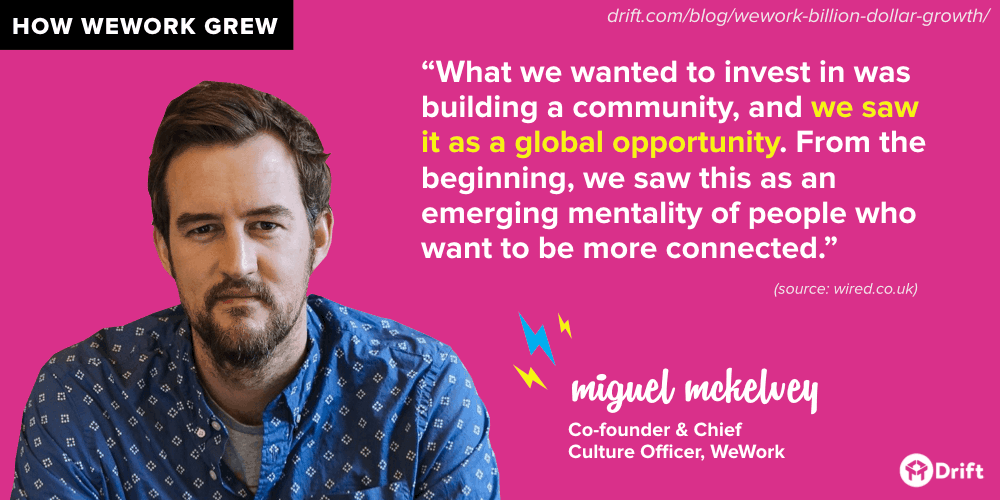
3) Grow with your customers.
For those of you who have been to a WeWork, what types of workers do you remember seeing in there? Let me guess: a bunch of solo entrepreneurs, designers, and other creative types, as well as plenty of founder duos, trios, and other small startups.
☝️ For years, that’s been WeWork’s bread and butter clientele. That’s who the original iteration of WeWork was built for and, clearly, WeWork did a stellar job of attracting those folks. Today, the company has more than 400,000 members working out of its coworking spaces.
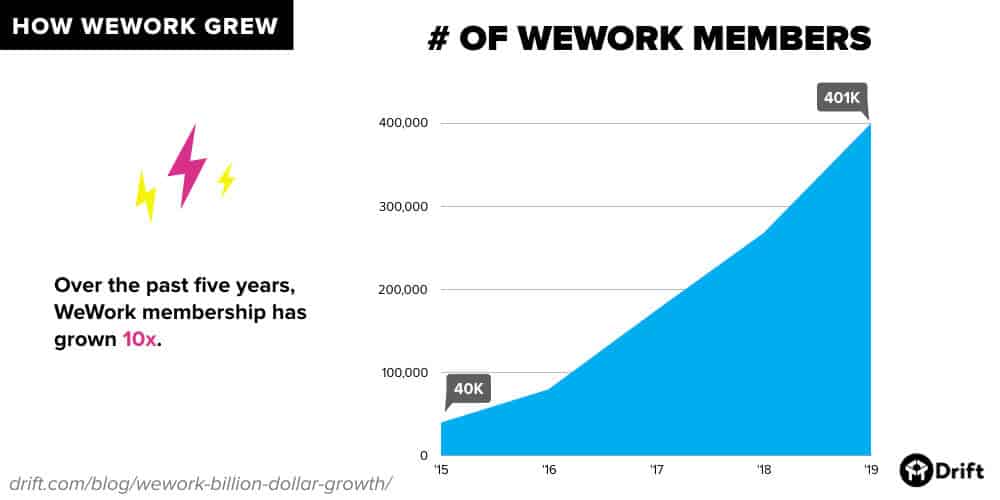
But here’s the thing about entrepreneurs and startups…They grow. And what WeWork realized is that at a certain point (usually when they reached about 12 people or so), their long-time, satisfied customers would inevitably leave and move into offices of their own. As WeWork’s chief growth officer, David Fano, told Wired:
Those companies were within the platform, but we weren’t going out of our way to serve them. Some of the companies were saying, ‘Look, we really just want our own space.’
Instead of waving goodbye to these companies and focusing exclusively on the startup market, WeWork made a conscious decision to grow with their customers. Hence, they unveiled a new service: HQ by WeWork, which offers private, decked-out office spaces to companies that outgrow WeWork’s traditional coworking environments. That way, WeWork is able to stick with its customers for longer. As David explained:
That’s our ultimate dream, that companies stay with us for life. From being a single-person startup to the day that they’re Airbnb.
WeWork predicts that by the end of 2019, HQ by WeWork will lead to approximately 70,000 new members.
However, it’s important to call out that this shift toward serving larger companies doesn’t change WeWork’s fundamental vision. As CEO Adam Neumann told Wired:
WeWork was, and still is, a company that’s making its best efforts to create a world where people make a life and not just a living. The biggest shift is, we’ve grown up a little bit.
And while Adam certainly didn’t expect that WeWork would grow up so fast, he always had an eye on the enterprise. In his view, serving the enterprise is really no different than serving any other company. After all, you’re still catering to a group of people, just on a larger scale. To quote Adam:
Enterprise was always the goal. I just didn’t think it would be this soon…
I don’t look at enterprise as a company with 100,000 employees. I look at them as 100,000 individuals that chose to come together.
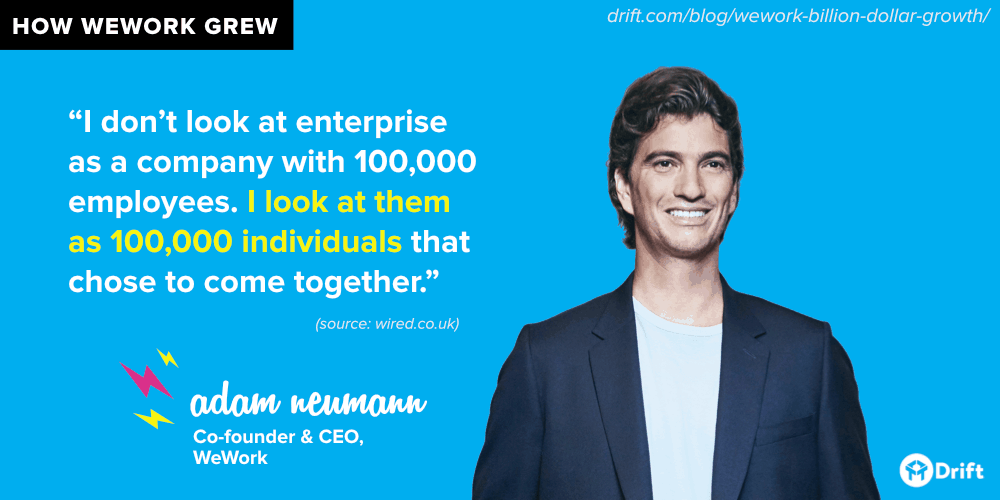
Ultimately, WeWork’s expansion into the enterprise is just the tip of the iceberg when it comes to the company’s explosive growth. In addition to expanding vertically, they’re expanding horizontally — they’re moving beyond the office and bringing their vision to other spaces, including residences (WeLive), gyms (Rise), and even a kindergarten (WeGrow). In fact, all of this growth has led to WeWork outgrowing its original name. Recently, the company unveiled its new moniker, The We Company. (“WeWork,” meanwhile, remains the name of their core, coworking space business, which has been our primary focus in this article.)
With a new customer segment to target, a new set of services to market and sell, and, on top of that all, a rebrand to manage, it’s gotta make you wonder… how does the WeWork team do it? How can a company support and sustain that level of growth?
4) Build a culture that supports rapid growth.
As in life, the only constant in business is change. And, as you’ve learned, this is a philosophy that WeWork co-founders Adam Neumann and Miguel McKelvey seem to embrace wholeheartedly. Remember: Before getting into the coworking space business, Adam owned a children’s clothing company, and Miguel was an architect. When they launched and scaled WeWork, they had to adapt on the fly and learn all they could as the company progressed. And this adaptability definitely carries over into the way WeWork manages its company culture today.
According to Miguel, people sometimes lament the fact that their established company culture gets diluted or otherwise changes as the company grows and expands. But here’s the thing: Company culture isn’t meant to be static, nor is it meant to be retrospective — when shaping culture, you should be looking forward, not backward. Or as Miguel put it:
Culture is not a game of nostalgia. Culture is a tool. It’s an instrument you use to drive a business to scale. You have to constantly design and redesign culture for each additional level up that the organization makes in scale or reach or impact or value.
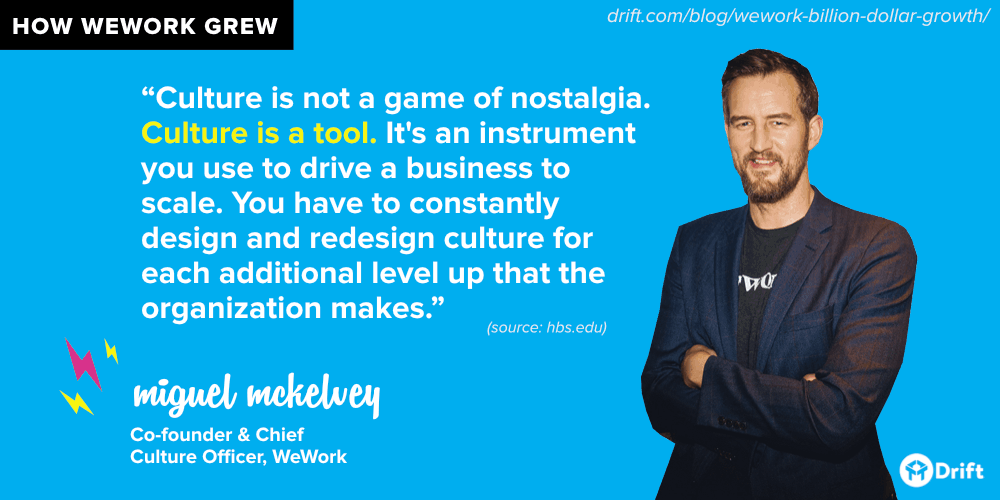
At WeWork, Miguel — the company’s Chief Culture Officer — ended up putting his architect’s brain to work in designing WeWork’s culture operating system, or “Culture OS.” He approached the task the same way he approached designing a coworking space, only instead of moving desks around, he was studying managerial processes and organizational structures. In the end, Miguel and the WeWork team established 8 pillars of their Culture OS.
- Purpose (Why do we matter?)
- Leadership (How do you deliver on our purpose?)
- Space (How are office spaces and online spaces designed?)
- Citizenship (How do you contribute value to the community?)
- Connection (Are you building relationships with one another?)
- Performance Agility (Are you being proactive, or reactive?)
- Talent (Are you investing in the best people?)
- Platforms (What tools and systems are using to create the work environment you want?)
For Miguel, these pillars of the Culture OS are purposefully void of terms like “Teamwork” and “Integrity,” which he sees as outputs of a great company culture. In order to build that culture, you need to be focused on the inputs. To quote Miguel:
What I’m interested in as a designer, as a manager, as a leader, is to figure out what are my levers? What are the inputs? How can I actually shape the culture that I want?
Final Thought
So, there you have it: Four key lessons that led to WeWork growing from $0 to $47 billion in less than a decade. Here’s a quick recap of how they pulled it off:
